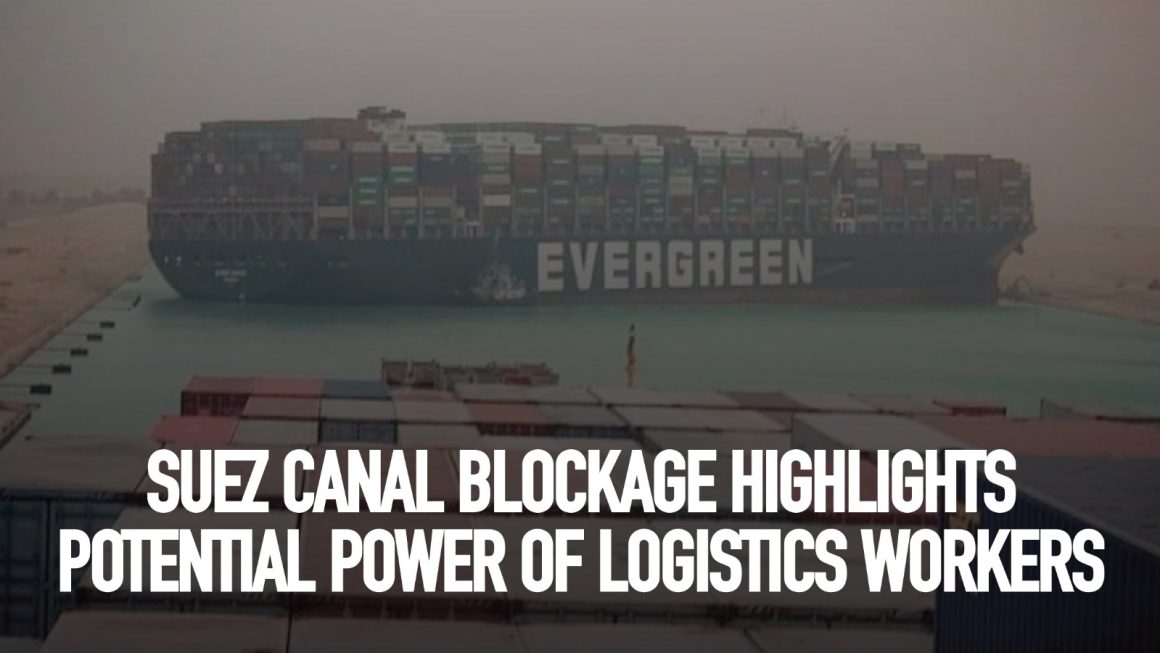By Dan O’Rourke
The recent obstruction of the Suez Canal by the Ever Given points to the vulnerabilities of the profit-driven global logistics system. It is likely that this is the first of many ‘choke points’ disrupting world trade in the coming period, with others identified by analysts including Black Sea Ports, the Panama Canal and the Strait of Malacca. As weather conditions worsen under climate change, oversized ships will again make headlines as they bring global trade to a standstill.
Looked at another way, the incident also points to the potential for workers internationally — who are more connected now than ever before — to use these vulnerabilities to their advantage in order to defend and fight for their interests, if and when necessary. In doing so, we should learn from the example of previous logistics strikes that won gains for the workers.
What caused the blockage?
Cost cutting imperatives mean that design flaws are built into critical infrastructure in most profit driven ventures. The Suez Canal is no exception.
As the Ever Given (the name of the ship operated by the Taiwanese shipping company Evergreen) was passing through the canal, strong winds caught the sides of the massive ship, pushing it into the bank. The captain was forced to increase speed in order to correct for the wind’s attempt to push the ship aground. The speed limit in the canal is between 7.6 knots and 8.6 knots. The Ever Given was forced to travel at 13.5 knots to make corrections. Almost double the speed limit. The ship also had no tugboat escort, which could have prevented the historic accident.
The massive size of the ship, the narrowness of the canal, the absence of a tugboat escort, the strong winds, and the heightened speed all combined to run the ship aground.
In the last ten years ships have doubled in size, from 10k to 20k containers. In that time the International Maritime Organisation has not mandated any upgrades to crew sizes or technology. As climate change bites these massive ships, larger than any aircraft carrier, will continue to make headlines as their ungainly size, lack of up to date technology and small crew size find it difficult to battle against worsening weather conditions.
Potential for workers
Logistics is crucial to the workings of the capitalist system, and getting products from factory or farm, to other factories, retailers and ultimately to consumers. This means that whether it’s a worker on a massive ship, or the hand that scans the final product across the barcode, logistics and retail workers have the potential to throw a spanner into the mechanics of the global profit system.
Ever since the invention of the shipping container after WW2 the logistics industry has been increasingly concentrated and monopolised. Logistics workers are concentrated in fewer companies and smaller geographic locations. This provides them with better potential to organise and build solidarity links. The attempted unionisation of warehouse workers at the Amazon facility in Bessemer is one such example.
Today, Walmart and Amazon, two of the world’s biggest employers, are essentially logistics companies. Their main export is capital and they import physical goods. They act as major consumer goods distribution centres for the world economy, relying on poorly paid workers in order to maintain their narrow profit margins. The global supply and production chain is more spread out than ever with some materials being shipped across the world multiple times before being finally assembled and sold. Modern production is also based on ‘just in time’ processes meaning there is very little room for delay in delivery of parts and materials. All of this creates a system of logistics that is extremely brittle. A relatively small but organised strike could shatter the illusion of smooth operations.
Here we look at various times when logistics workers used their power to halt the capitalist system in order to fight back against exploitation and oppression. Some are more historic than others, but each one represents an important lesson on strike tactics:
EVA Air cabin crew strike
In July 2019, more than 2,300, mostly women, cabin crew at Taiwan’s EVA Air ended a strike after winning increased stipends and concessions from the airline owners. The strike grounded 1,200 flights and disrupted 300,000 individual passenger journeys. Untold amounts of cargo was also delayed and rerouted. The strike was triggered by the need for increased pay, working conditions, and by the bad treatment by largely male management towards the women workers.
Hong Kong Dockers Strike
In May 2013, 500 workers in Hong Kong ended a 40 day strike. The Hong Kong Confederation of Trade Unions (HKCTU) representing the striking workers reached an agreement for a nearly 10% pay increase. It was Hong Kong’s longest-running industrial struggle since the 1922 Seamen’s Strike, which lasted 55 days.
Panama Canal
The Panama Canal, the Suez’s Latin American counterpart that connects the Pacific to the Atlantic is another man made shipping choke point vital to international shipping and trade. In January 2012 workers on the Panama Canal’s expansion project won significant wage increases after striking for a mere seven days. The management agreed to an audit on overtime payments, compensation leave and work hours, as well as to reinstate a worker dismissed over a dispute with a supervisor.
Suez canal strike
The workers at the Suez canal certainly understand their power and have wielded it effectively on numerous occasions. Not least, during Egypt’s ‘Arab Spring’ when they joined the 2011 general strike. The strike was a key factor in ending the reign of Hosni Mubarak.
Chilean Truckers Strike
In September 2020, truckers in Chile gained important safety and security gains after striking for one week. The billionaire president, Sebastian Pinera, reluctantly gave in to demands, while also condemning the tactics of the Truckers. The week-long standoff created significant port backlogs, with a port official saying almost no export shipments left as scheduled.
Red Sea Port Strike During the Sudanese Revolution
During the 2019 Sudanese revolution workers at the Red Sea Port, which is not far from the Suez, called a strike in support of demands for greater democracy. Port Sudan was among the first to participate in the revolution and it had a large and inspirational role in spreading the uprising to the rest of the country. The port strike was called in May, and by June millions of Sudanese workers joined a general strike.
UPS Workers Strike of 1997
The United Parcel Service strike of 1997, led by the Teamsters union, started in August 1997, and involved over 185,000 teamsters. The strike shut down UPS operations for 16 days and cost UPS $600 million. The strike was a victory for the workers, resulting in a new contract that increased their wages, secured their existing benefits and gave increased job security. The strike was the largest the country had seen. In addition, UPS agreed that they would now be required to discuss any future package weight limit increases with the Teamsters. UPS agreed to stop subcontracting, with the exception of peak times and to create 10,000 full-time jobs from part-time positions.
Moving forward with determination
As the pandemic lifts, so will the emergency financial relief provided by unwilling neoliberal states. A so-called ‘K shaped’ recovery will mean workers will face conditions similar to those faced by the workers mentioned above. Meanwhile, wealth will continue to congeal in the hands of the already wealthy. Logistics workers will undoubtedly again play a vital role in the struggles in the coming period. Building and strengthening the organisation and solidarity links between logistics workers internationally is an urgent task.












